Key takeaways
- Travis Scott creates an immersive musical atmosphere by blending traditional rap with psychedelic and ambient sounds, encouraging listeners to experience a new dimension of rap.
- His innovative use of vocal effects and layering techniques adds emotional depth, inviting listeners into a personal and intimate connection with his music.
- Scott has influenced modern rap trends by normalizing experimentation and opening the door for artists to explore mood-driven soundscapes and emotional vulnerability.
- Future rap innovation is expected to focus on immersive soundscapes and bold experimentation, potentially incorporating technology like virtual reality and AI-generated sounds.
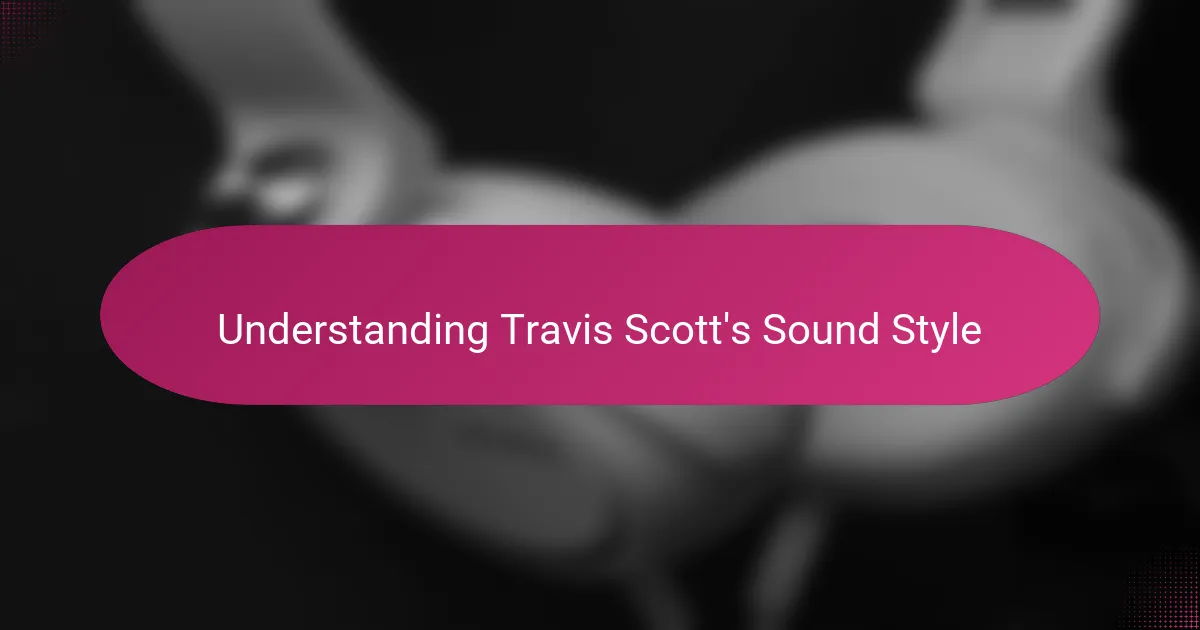
Understanding Travis Scott’s Sound Style
Travis Scott’s sound style instantly grabs my attention because it’s not just about the beats or lyrics—it’s an entire atmosphere he creates. Have you ever listened to one of his tracks and felt like you were in a different world? That’s the kind of immersive experience his music consistently delivers.
What fascinates me the most is how he blends traditional rap elements with psychedelic and ambient sounds. It’s like he’s painting a sonic landscape that pulls from chaos and calm, which keeps me hooked every time. This fusion challenges listeners to rethink what rap music can be.
I also notice how Scott’s use of vocal effects adds layers of emotion and depth. His voice sometimes feels distorted or echoed, almost like a distant shout through a cavern. Doesn’t that make you wonder about the feelings behind those sounds? It’s this emotional complexity that makes his style stand out in today’s rap scene.

Key Elements of Innovative Rap Music
When I think about what makes rap truly innovative, it comes down to how artists use sound to push boundaries. It’s not just rapping faster or harder; it’s about weaving unexpected textures and moods into the beats. Have you ever heard a track that felt fresh because it mixed genres or used instruments you didn’t expect in rap? That surprise element is what often hooks me the most.
Innovation in rap also means experimenting with production techniques that challenge the norm. Sometimes I find myself replaying a song just to catch subtle layers—like a haunting sample or a glitchy synth—that aren’t obvious at first. Those intricate details add a whole new dimension, making the music feel alive and evolving.
And then there’s the emotional connection created through these elements. When an artist uses distortion or reverb on their voice, for instance, I feel it brings a rawness that’s almost vulnerable. Doesn’t it feel like they’re inviting you into a secret space of their mind? To me, that vulnerability wrapped in sonic creativity is what makes innovative rap resonate so deeply.
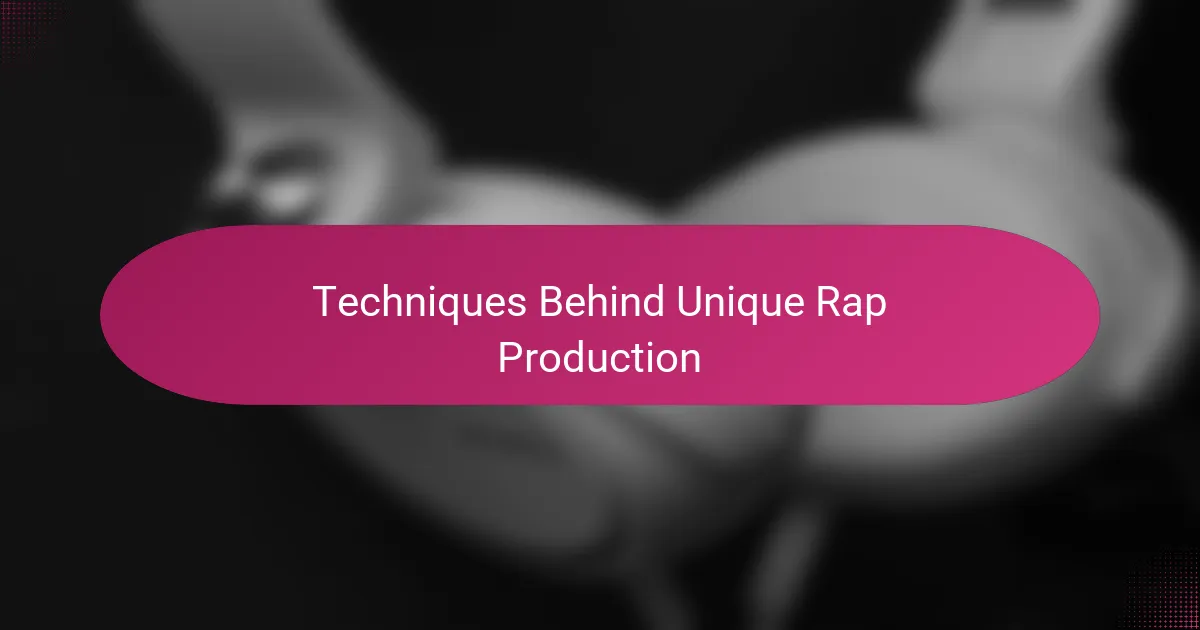
Techniques Behind Unique Rap Production
One technique that really stands out to me in Travis Scott’s production is his masterful use of layering. He stacks sounds—whether it’s synths, samples, or effects—in a way that creates this dense, almost tactile texture. Have you ever noticed how you can discover something new each time you listen? That’s intentional; it makes the whole track feel alive, like it’s constantly unfolding.
Another thing I find fascinating is his approach to vocal manipulation. Instead of just delivering lyrics straightforwardly, he treats his voice like another instrument—pitch-shifting, distorting, and blending it into the mix. It’s almost like his voice becomes a ghostly presence, adding an eerie, emotional depth that pulls me in every time. I wonder, does this make you feel closer to the emotional core behind the music?
Finally, he often experiments with unconventional sound sources and unexpected effects, breaking away from traditional rap production formulas. For example, he layers ambient noises or psychedelic elements that would seem out of place anywhere else but fit perfectly here. In my experience, that willingness to take risks is exactly what gives his music that unique edge. Don’t you think those surprises keep the genre evolving?
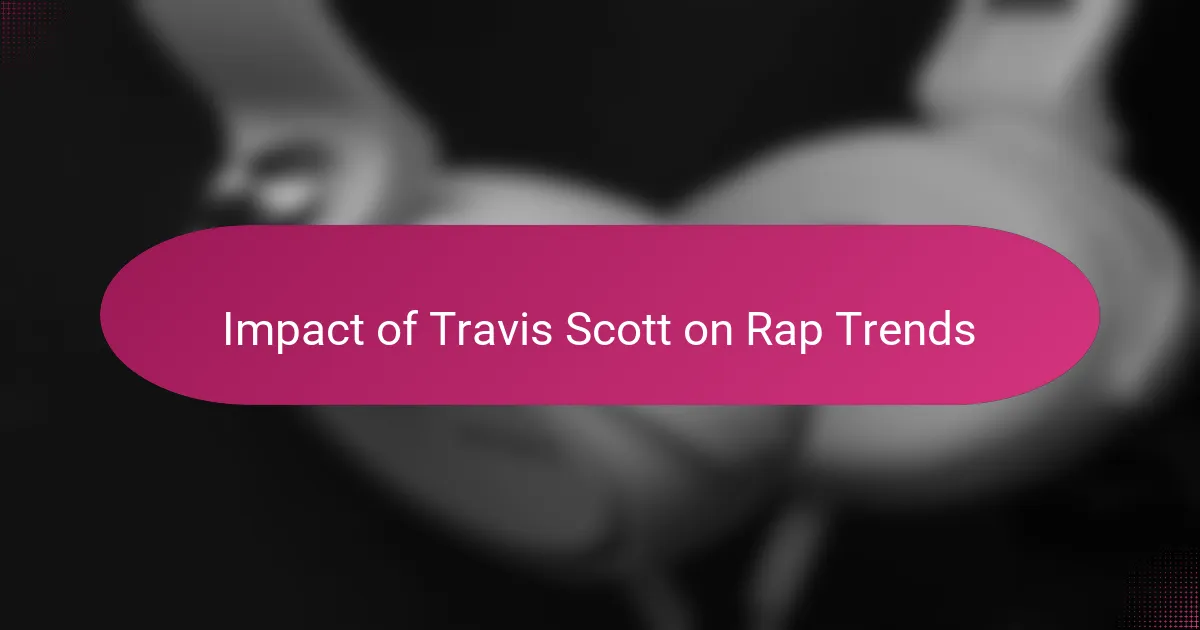
Impact of Travis Scott on Rap Trends
Travis Scott didn’t just follow rap trends—he shaped them in ways I find both unexpected and exciting. His fusion of atmospheric production with trap beats sparked a wave of artists exploring mood-driven soundscapes. Have you noticed how many rappers now incorporate ambient textures that feel almost otherworldly? That’s Scott’s influence seeping into the core of modern rap.
What really strikes me is how his creative risks have normalized experimentation in a genre that once felt rigid. When I first heard “Astroworld,” it was like a blueprint for blending commercial appeal with artistic innovation. I often think about how this shift encourages newer artists to push boundaries without fearing they’ll lose their core audience.
On a personal note, watching Travis’s impact unfold makes me appreciate how rap trends can evolve beyond simple lyricism or beats. His style invites listeners to experience emotion through sound layers and vocal effects, changing how we connect with rap. Doesn’t it feel like he’s opened a door to a more immersive, almost cinematic form of storytelling in hip-hop?
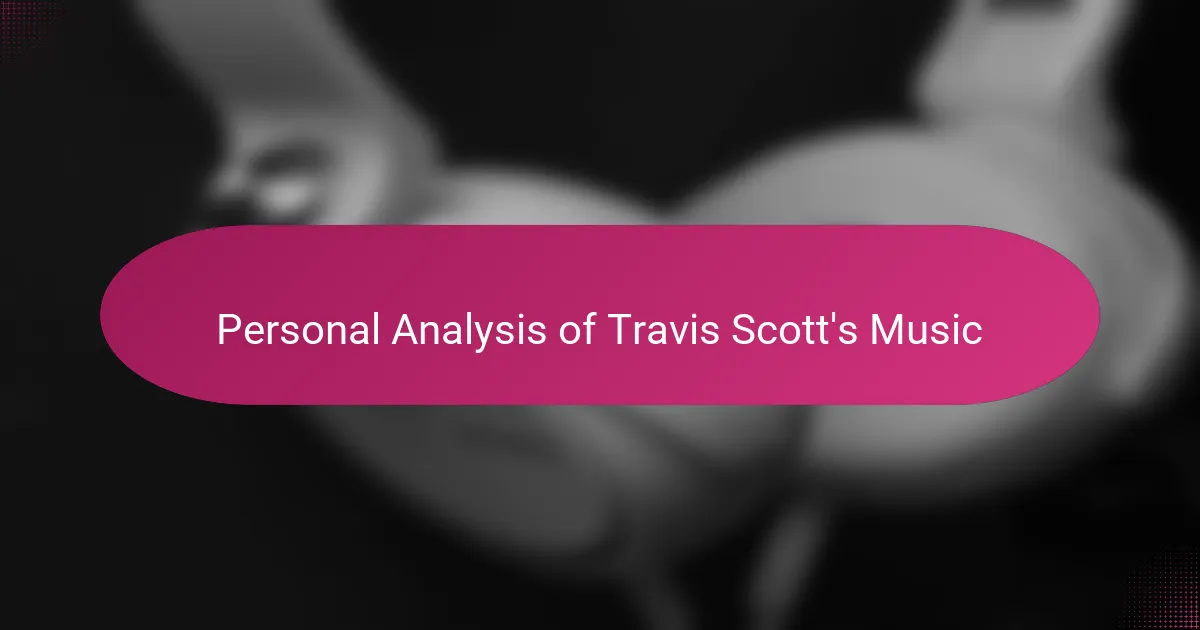
Personal Analysis of Travis Scott’s Music
Travis Scott’s music strikes me as a deeply personal journey wrapped in innovative sound. When I listen, it feels less like a typical track and more like stepping into an emotional landscape he’s carefully crafted. Have you ever caught yourself replaying a song just to get closer to what he’s really expressing beneath those layered effects? That’s the kind of connection his music fosters for me.
What’s fascinating is how his melodies often evoke a sense of loneliness or introspection, even amid high-energy beats. I remember the first time I heard one of his songs late at night—it was like the sound captured both the chaos and quiet moments swirling in my own mind. Doesn’t that duality make his music feel so much more relatable, even though it sounds so experimental?
I also can’t help but admire how Travis balances accessibility with complexity. While his tracks might feel abstract on the surface, there’s a rawness in his vocal delivery that pulls me in emotionally. It’s as if his music invites me to explore the shadows and thrills of life, making each listen an immersive experience rather than just background noise. Would you say that’s what sets his sound apart in today’s rap scene?
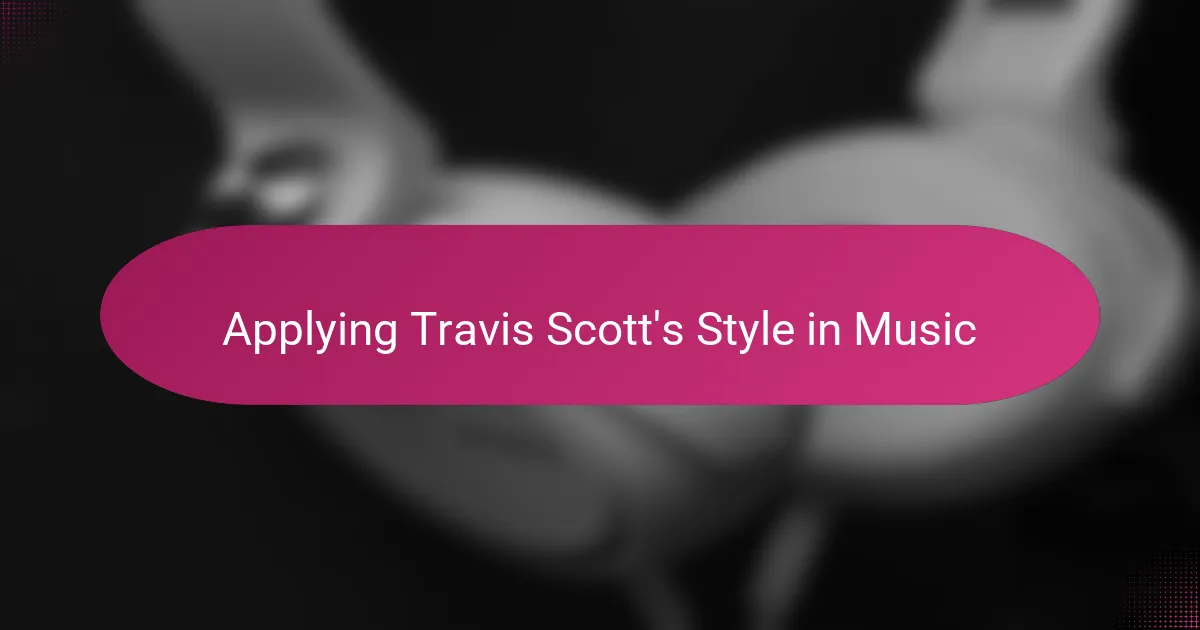
Applying Travis Scott’s Style in Music
When I try applying Travis Scott’s style in my own music, I realize it’s not enough to mimic his sounds. It’s about capturing that atmospheric depth—layering synths and vocal effects so the track breathes and evolves. Have you ever felt stuck trying to recreate his vibe? I find it helps to think less about copying and more about crafting an immersive mood.
One thing I’ve learned is the power of vocal manipulation. Instead of delivering bars plainly, I experiment with pitch-shifts or subtle distortion. It adds emotion and texture, like my voice becomes an instrument of feeling, not just words. Does that kind of vulnerability in sound make your music more relatable? For me, it opens up new creative doors I hadn’t considered before.
Lastly, I often mix unconventional sounds—ambient noises or psychedelic elements—into my beats, inspired by Travis’s fearless production. At first, it felt risky, but it really pushes the track beyond typical rap boundaries. Isn’t that risk-taking what transforms a track from ordinary to memorable? Embracing that mindset has definitely changed how I approach making music.
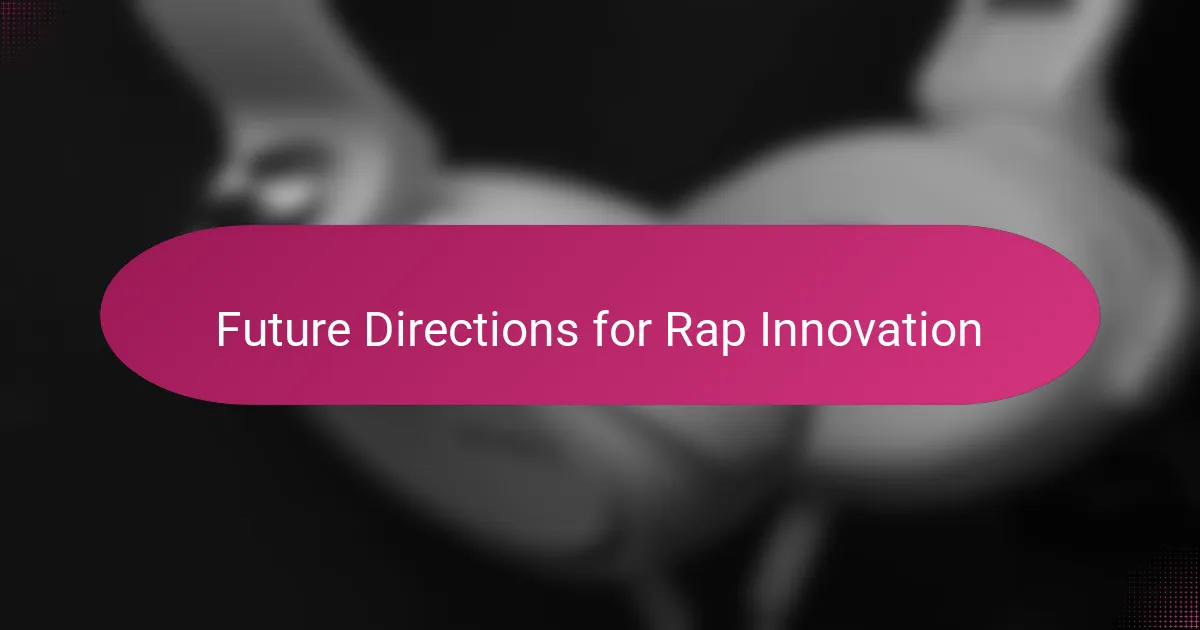
Future Directions for Rap Innovation
Looking ahead, I believe rap innovation will continue to lean into immersive soundscapes, much like Travis Scott pioneered. I imagine artists layering even more complex textures, using technology to create atmospheres that feel almost tangible. Have you thought about how virtual reality or AI-generated sounds might blend with rap? To me, that fusion could open entirely new creative playgrounds.
At the same time, I sense there’s a growing appetite for emotional vulnerability wrapped in sonic experimentation. What if future rappers push vocal manipulation even further, breaking down the barrier between voice and instrument? From my experience, the more I hear that raw, distorted honesty, the more I feel connected—not just to the music, but to the artist’s story.
Lastly, I’m curious about how risk-taking will evolve within the genre. Travis’s fearless blending of genres and effects raised the bar, but where do artists go from there without losing authenticity? In my own creative journey, embracing uncertainty has led to my most memorable sounds, so I’m excited to see how the next wave of rap innovators will redefine the rules—and maybe even rewrite them altogether.
